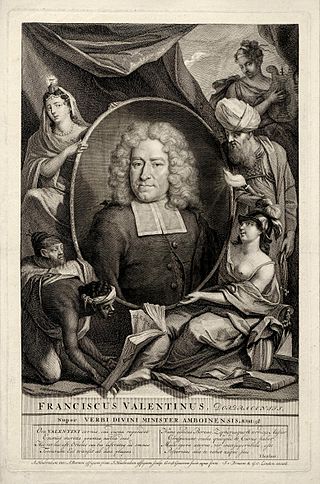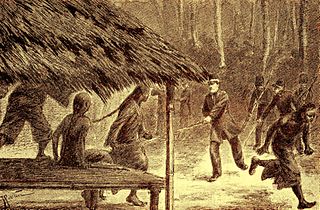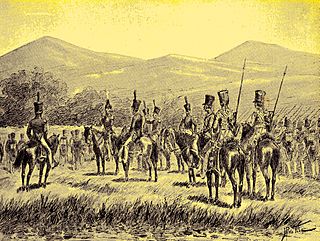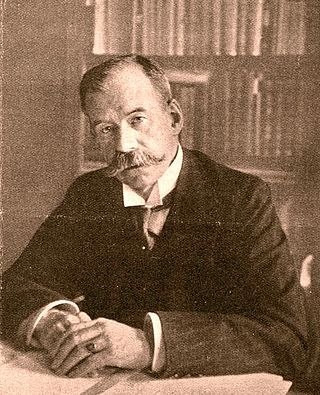
The United East India Company, commonly known as the Dutch East India Company, was a chartered trading company and one of the first joint-stock companies in the world. Established on 20 March 1602 by the States General of the Netherlands amalgamating existing companies, it was granted a 21-year monopoly to carry out trade activities in Asia. Shares in the company could be purchased by any citizen of the United Provinces and then subsequently bought and sold in open-air secondary markets. The company possessed quasi-governmental powers, including the ability to wage war, imprison and execute convicts, negotiate treaties, strike its own coins, and establish colonies. Also, because it traded across multiple colonies and countries from both the East and the West, the VOC is sometimes considered to have been the world's first multinational corporation.

Dutch New Guinea or Netherlands New Guinea was the western half of the island of New Guinea that was a part of the Dutch East Indies until 1949, later an overseas territory of the Kingdom of the Netherlands from 1949 to 1962. It contained what are now Indonesia's six easternmost provinces, Central Papua, Highland Papua, Papua, South Papua, Southwest Papua, and West Papua, which were administered as a single province prior to 2003 under the name Irian Jaya, and now comprise the Papua region of the country.
The First expedition to Palembang was a punitive expedition of the Royal Dutch East Indies Army to Palembang in 1819. The expedition ended in a failure for the Dutch.

The second expedition to Palembang was a punitive expedition by the Dutch against the Palembang Sultanate in 1821. The commander of the expedition, Hendrik Merkus de Kock, succeeded in coming to an agreement with Sultan Mahmud Badaruddin II.

François Valentyn or Valentijn was a Dutch Calvinist minister, naturalist and author whose Oud en Nieuw Oost-Indiën describes the history of the Dutch East India Company while also making notes on geography, ethnography, and natural history; half is about the Moluccas. The work is characterised by vanity, randomness, imbalance and the lack of systematics. Valentyn even used sources that he considered unreliable shows his urge to describe the pre-colonial history of Asia as well. Some of his descriptions were far-fetched.

The expedition against the Chinese in Montrado (1854–1855) was a punitive expedition of the Royal Netherlands Indies Army against Chinese kongsi in Montrado (Borneo).

The Expedition to the West Coast of Borneo was a punitive expedition of the Royal Netherlands East Indies Army against the Chinese Indonesian independence republic at Pontianak, Mandor and Monterado in 1823.

The Palembang Bovenlanden Expeditions were punitive expeditions by the Royal Netherlands East Indies Army to Palembang in South Sumatra (1851–1859).

The Pasoemah Expedition was a punitive expedition of the Royal Netherlands East Indies Army to the Pasoemah region in South Sumatra. The expedition lasted from 1864 to 1868.

The First Bone War was a series of punitive expeditions of the Royal Netherlands East Indies Army against the Bone state in South Sulawesi in 1824–25.

The Dutch expedition to the west coast of Sumatra was a punitive expedition of the Royal Netherlands East Indies Army in 1831. The United States Navy, responding to the same incident, sent a punitive expedition in 1832.

Dutch intervention in Bali of 10–26 December 1858 was the fourth punitive expedition of the Royal Netherlands East Indies Army (KNIL) on the island. This expedition was directed against certain chiefs (pungawwa) of Buleleng who were fomenting revolt and opposition to the Dutch-appointed regent.

Conrad Theodor "Coen" van Deventer was a Dutch lawyer, an author about the Dutch East Indies and a member of parliament of the Netherlands. He became known as the spokesman of the Dutch Ethical Policy Movement. He lived at Surinamestraat 20, The Hague (1903–1915), former residence of John Ricus Couperus, his son writer Louis Couperus and the rest of his family (1884–1902).
Jacobus Anthonie Meessen was a Dutch photographer who took more than 250 portraits and landscapes of the Dutch East Indies between 1864 and 1870. Born to a carpenter in Utrecht, Meessen worked in that trade in the Indies before marrying in the Netherlands in the early 1860s. He returned to the colony in 1864, intent on documenting its land and people. He worked mostly in the capital of Batavia, Java, and Padang, Sumatra; he also photographed Bangka, Belitung, Borneo, and Nias.
Balthazar de Moucheron (1552-1630) was a Dutch trader, ship owner, and one of the founders of the Dutch East India Company, but never participated as he went bankrupt in the same year. He is known for his early trading with India (Calcutta) and Indonesia, America, the west coast of Africa, the Baltic Sea, and the White Sea (Archangelsk).

A voorcompagnie (pre-company) is the name given to trading companies from the Republic of the Seven United Netherlands that traded in Asia between 1594 and 1602, before they merged to form the Dutch East India Company (VOC). The pre-companies were financed by merchants from the Northern Netherlands and rich immigrants from the Southern Netherlands. Because of the deadly competition, the government forced the smaller trading companies to unite and form the (United) East India Company. In its turn, it received the exclusive rights for the trade with Asia for the following 21 years.

The Compagnie van De Moucheron was a pre-company and precursor of the Verenigde Oost Indische Compagnie, from the Republic of the Seven United Netherlands. It was founded by Balthazar de Moucheron, a ship owner from Antwerp in the Southern Netherlands. After the fall of Antwerp he moved his business to Zeeland. The fleet of the Compagnie van De Moucheron was made up of three ships, 'Ram', 'Schaap' (Sheep) and the pinasse 'Lam' (Lamb) and was headed by Joris van Spilbergen. Its fleet left on 5 May 1601 and returned to the Republic of the Seven United Netherlands in 1604.

The Veerse Compagnie was a pre-company from the Republic of the Seven United Netherlands that was founded by Balthazar de Moucheron, a ship owner from Antwerp in the Southern Netherlands. After the fall of Antwerp he moved his business to Zeeland. The fleet of the Veerse Compagnie was made up of two ships; 'Leeuw' (Lion) and 'Leeuwin' (Lioness) and was headed by Cornelis Houtman. Its fleet left from Veere on 28 March 1598 and returned to the Republic of the Seven United Netherlands in 1600.

Reyer or Reynier Pauw, was an influential Amsterdam regent of the Golden Age. Pauw was pensionary and eight times mayor of Amsterdam. He was involved in the Compagnie van Verre, the VOC, and the trial of Johan van Oldenbarnevelt.

The Old Company was a pre-company of the Dutch Republic and originated from the Company of Verre and the New Company, from Amsterdam, in 1598. The directors were Dirck van Os, Jan Hermansz, Jan Janss Carel (Kaerel) and Geraerdt (Gerrit) Bicker. Directors with a smaller share of the investment were: Vincent van Bronckhorst, Symon Jansz Fortuyn, Geurt Dircxz, Cornelis van Campen, Jacob Thomasz Van den Dael, Elbert Simonsz Jonckheyn, Petrus Plancius, Syvert Sern, Jan Poppe, Geurt Dirckss and Pieter Hasselaer. The Old Company and the (New) Brabant Company would merge in 1601 and become the United Amsterdam Company.














